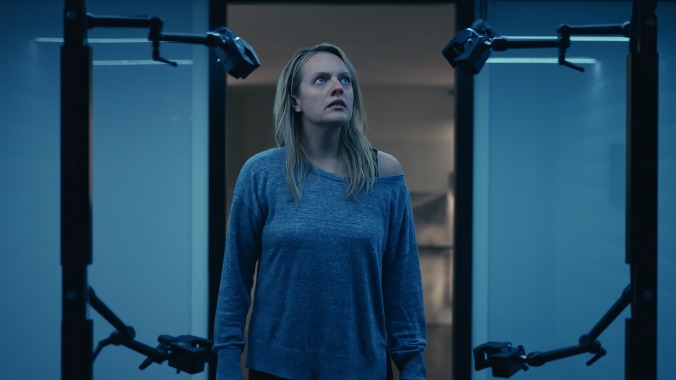A new version of The Invisible Man makes one of his victims intensely visible

The Invisible Man has always been something of an outlier among the storied Universal Monsters. Dracula, Frankenstein’s Monster, and the Wolf Man are all essentially former men whose glimmers of humanity are subsumed in their dramatic transformations. The Invisible Man’s origins, by contrast, are more akin to a second-tier comic book supervillain. He doesn’t become stronger, more toothsome, or undead. He’s a guy who obtains the power of invisibility, and does a bunch of bad stuff with it. Though previous versions of the story have implied that invisibility messes with his brain chemistry, to some degree he’s monstrous by choice, not by chance. This makes him both the most human Universal monster and the least sympathetic.
Leigh Whannell’s extremely effective new thriller The Invisible Man (risen from the ashes of a more lavish Dark Universe initiative) leans into both of those aspects of the character by making him less visible than ever. Following unnerving credits that unfold over black ocean waves crashing against a shoreline, the movie opens on Cecilia (Elisabeth Moss), sleepless in the wee hours of the morning. She carefully avoids rousing her mostly unseen bedmate Adrian (Oliver Jackson-Cohen) as she creeps out of their sleek modernist bedroom; Whannell summons so much dread, and Moss’s face is so expressively fraught, that her intentions are immediately clear. This is an escape plan.
Adrian is not invisible yet, though his screen time is scant. At this point, it’s Cecilia who yearns to disappear, and Adrian’s brief glass-smashing appearance explains why, if the ubiquitous menacing security cameras and his girlfriend’s demeanor weren’t enough clues that he’s an abuser. Before long, the universe seems to grant Cecilia a gruesome form of peace. While she’s hiding out with her single-dad friend James (Aldis Hodge) and his teenage daughter Sydney (Storm Reid), her sister (Harriet Dyer) shows up to tell her that Adrian has killed himself. Cecilia also learns that he has left her an enormous sum of money.
There isn’t much relaxation time before Cecilia starts to suspect all is not as it seems. She senses she’s being watched. A few objects around the house appear to shift positions. At one point, the barest outlines of footprints seem to materialize in the carpet. Other characters, not privy to Cecilia’s specific experiences (or the title of the movie), think she’s being paranoid, or maybe even acting out. After all, there’s no way Adrian could fake his own death and use his genius-level knowledge of optics technology to make himself disappear, is there? The 2020 version of the Invisible Man knows how to gaslight.
His movie, though, doesn’t completely follow suit with audience mind games. There’s not much ambiguity over whether Cecilia is right about her unseen stalker. Instead, Whannell makes an obvious change that has nonetheless eluded nearly a century’s worth of Invisible Man movies: The identification point here is not the remorseless guy who turns himself invisible but one of his victims, who is left searching frantically for signs of her attacker and ways to defend herself. In place of shots from the point of view of the invisible, the camera pans across rooms or down hallways with an uneasy searching that recalls the kind of refined spookhouse horror that was once stock in trade for Whannell and his former collaborator, James Wan.
Whannell’s Invisible Man is a sleek upgrade of his past horror work—and, for that matter, of Upgrade, the fun genre exercise he concocted a couple of years ago. As bloodier mayhem ramps up, the scares feel less jumpy and cheap than in an Insidious sequel; the cinematography by Stefan Duscio and musical score by Benjamin Wallfisch are polished to a particularly unnerving gleam to match Adrian’s glassy, shadowy compound. That said, the smooth surfaces don’t quite reach the edges of the film, where some of the supporting characters have a B-movie roughness in both their writing and performance. The Invisible Man is striking and tense, but not exactly rich; even some of the warmer characters like James and Sydney are mostly just peril fodder.
Moss, though, classes things up considerably. If there’s something a little bit queasy about turning a Universal monster movie into a domestic abuse/stalker thriller in the Sleeping With The Enemy vein, her performance functions as a dose of anti-nausea medicine. As with her less genre-friendly work with Alex Ross Perry, Moss combines skittish vulnerability with mesmerizing steeliness, the former stabilizing into the latter for moments of cornered resourcefulness. Her targets include some additional non-rampaging men who still earn Cecilia’s ire: She memorably describes one as the “jellyfish version” of her hateful ex. Moss also strengthens the notion that this is a monster movie unusually interested in looking past the toxic-male machinations of its famous character and toward the lasting horrors left in his wake. In other words, the stuff that previous movies, and real life, have sometimes tried to turn invisible.